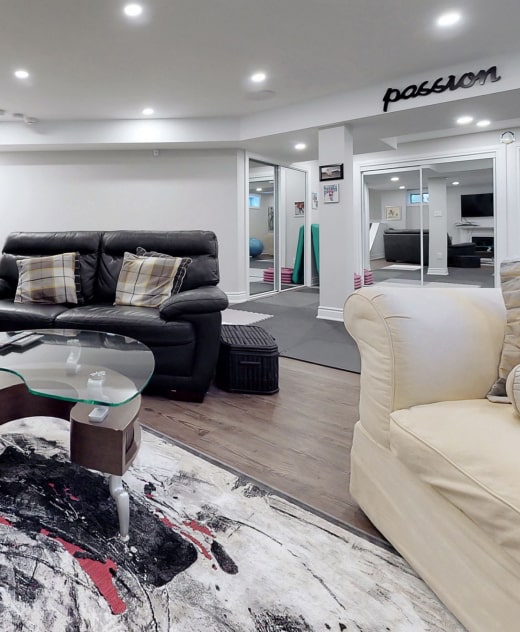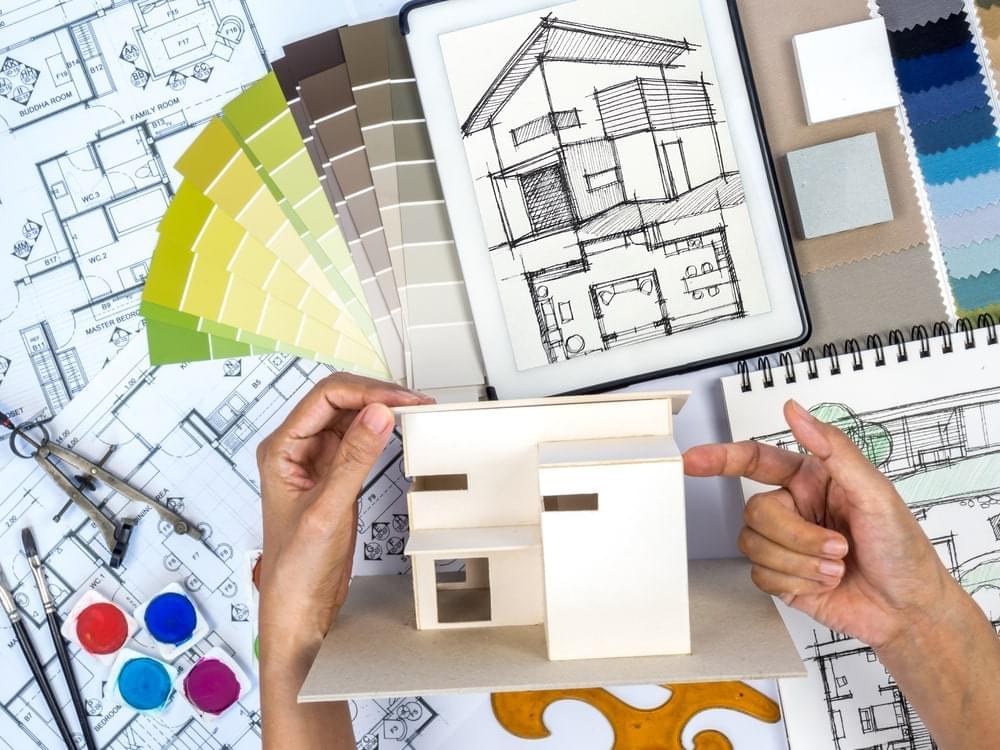Basement Gym Ideas on a Budget
On average, setting up a basement gym may cost a minimum of $1500 and a maximum of $7000 or more in Toronto, depending on the scope of work, materials required, and equipment added. It is worth considering basement finishing and basement underpinning, if necessary.
If you apply DIY methods and pocket-friendly solutions like creating custom shelving units and installing low pile carpet, the cost may be reduced. In this article, we explore the various realistic and on-budget basement gym ideas that you can consider to save you some coins.
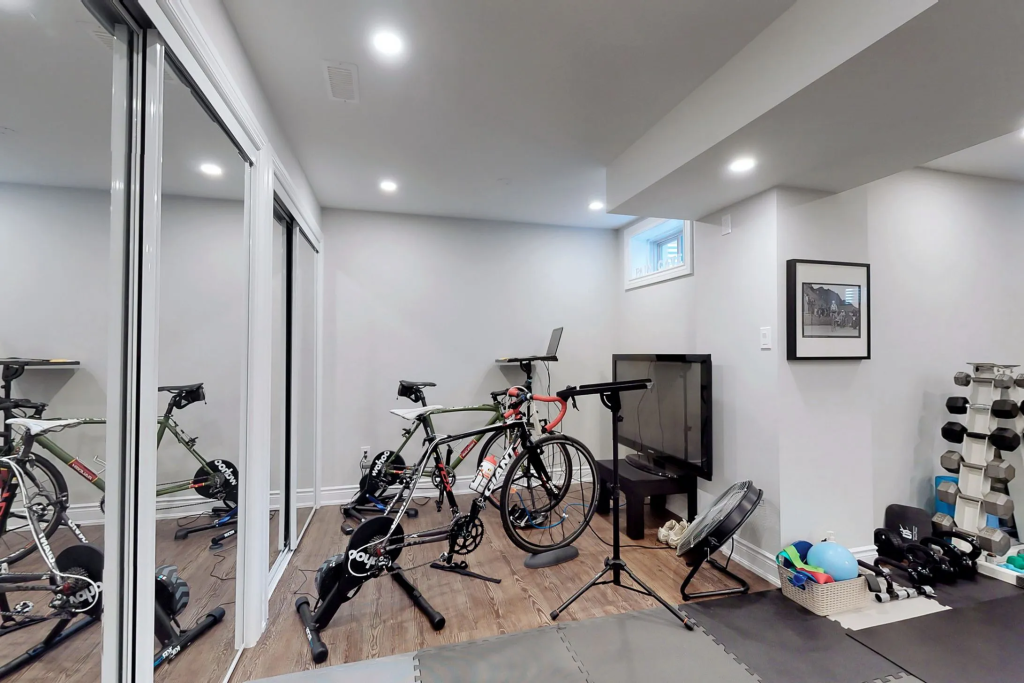
Basement Gym Flooring
The flooring option you choose should provide shock absorption, ease of cleaning, and durability. Fortunately, there are several pocket-friendly flooring ideas as outlined below that meet these requirements:
- Carpet Tiles: These are square sections of low pile carpet that can be laid down individually. Carpet tiles provide noise reduction, basic cushioning, and warmth and cost approximately $1-$2 per square foot. They are an ideal option for stretching, light equipment setup, and low impact workouts.
- Rubber Stall Mats: If you are designing a basement gym that caters to HIIT and heavy lifting and supports the heaviest fitness equipment, consider getting the rubber stall mats. This is because while they may cost more ($3 to $8 per square foot) compared to other flooring options, they are heavy-duty, extremely durable, slip-resistant, and have good shock absorption characteristics.
- Artificial Turf: This is a reasonable option for anyone looking for a combination of durability, aesthetics, and versatility. It is specifically suitable for sled pushes, bodyweight exercises, functional training, and agility while lowering the potential risk of injury. Artificial Turf is low maintenance, provides shock absorption, and requires about $1 to $6 per square foot, depending on thickness and quality.
- Vinyl Plank Flooring: Basements are prone to mold and moisture buildup, and vinyl plank flooring is a suitable choice designed to curb such issues. It is water-resistant synthetic flooring with a hardwood appearance, and it is stylish, easy to clean, and resistant to mold. Vinyl plank flooring is best for lighter workouts and multi-use gyms that double as recreation spaces and may cost between $2 and $4 per square foot.
- Interlocking Foam Tiles: Soft lightweight tiles that fit together, featuring cushioning for joints, variety in thickness, and easy do-it-yourself installation. Interlocking foam tiles cost roughly $1 to $5 per square foot and work well for yoga, light weight lifting, and bodyweight exercises.

Essential Equipment on a Budget for Your Gym in a Basement
Building a basement gym on a budget means focusing on versatility and space-saving gear that covers cardio, mobility, and strength. Examples of budget friendly essential equipment you can add include:
- Resistance Bands: Entails tube bands with handles, ankle straps, door anchors, and loop bands. They offer variable resistance, improving time under tension for muscle growth, and are perfect for assistance exercises like pull-ups, stretching, and warmups.
- Flat or Adjustable Bench: A padded bench that is used for strength and bodyweight exercises, enables dumbbell presses, dips, rows, setups, and more. An adjustable model adds incline/decline positions for added versatility.
Bumper Plates: Rubber coated weight plates designed to be dropped safely without damaging floors. They are quieter and safer than cast iron plates and are ideal for Olympic lifts, bench presses, squats, and deadlifts. - Yoga Mat: Essential for core work, cool downs, yoga, and warmups. Yoga mats provide comfort and grip during bodyweight movements, are easy to clean, roll up, and store in tight spaces.
- Squat Rack with Pull-Up Bar: Ideal for supporting compound lifts which give the best strength results, the pull-up bar adds upper body and core training options. Squat rack with a pull-up bar acts as the anchor for future upgrades like pulley systems or dip bars.
- Stability Ball: Helps build core strength and stability, enhances range of motion for stretching routines, is lightweight, and can be deflated for storage in small basement spaces.
- Adjustable Dumbbells: Ideal for space saving and it’s cost effective as buying one adjustable set is cheaper than buying a separate pair. Adjustable dumbbells offer versatility, as they can be used for strength training, isolation exercises and circuit training.
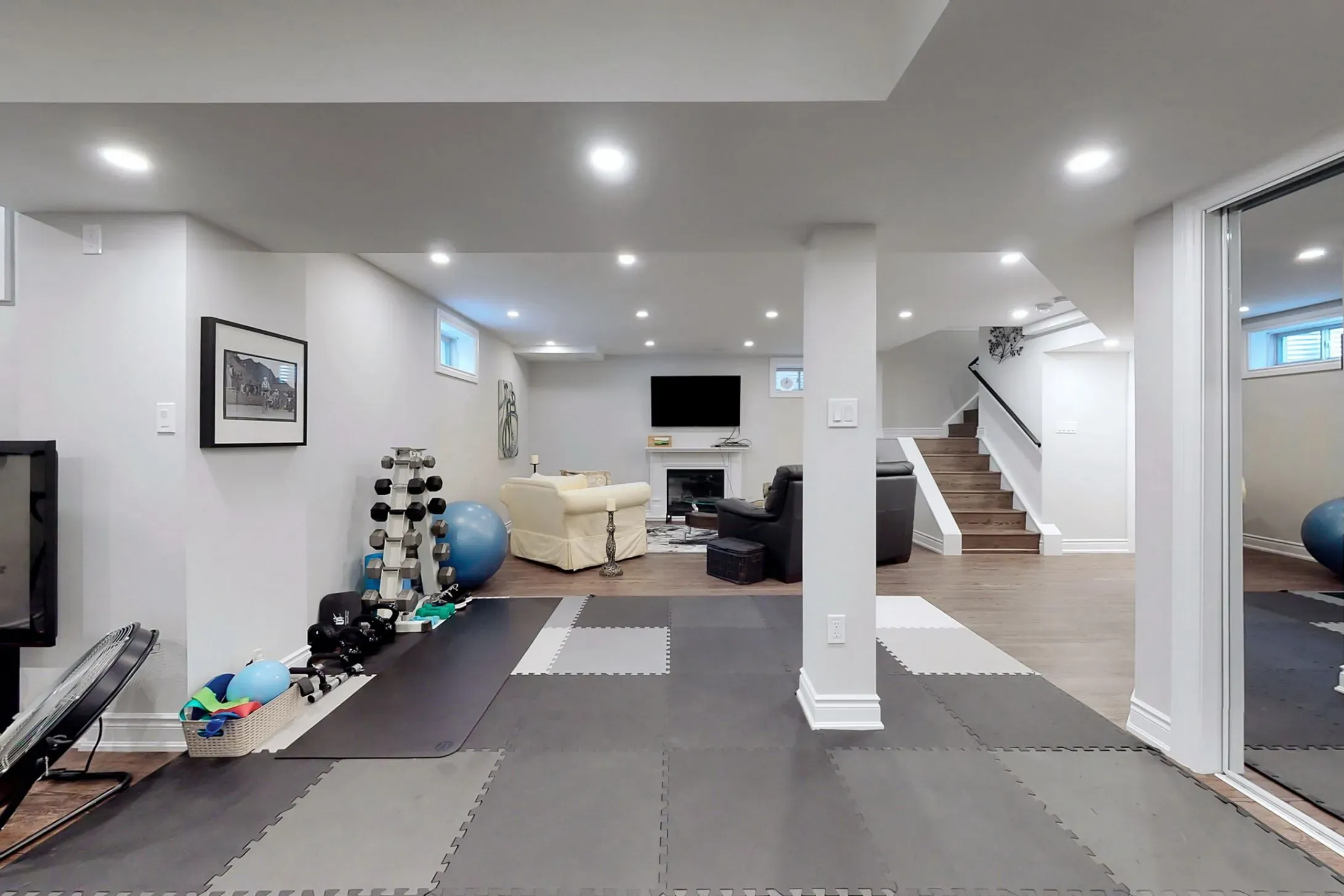
Storage Solutions for Your Sports Equipment
Here are some low cost storage ideas to maximize space and keep your basement gym organized:
- Wall Hooks at Varying Heights: Entails simple wall mounted hooks that are either directly installed into the wall or on pegboards that allow for vertical hanging storage. Wall hooks help store resistance bands, lightweight kettlebells, exercise towels, and jump ropes. They are affordable, save vertical space, and their customizable height means you can design for different user heights or equipment sizes.
- Plastic Bins Under Benches: Add standard bins or containers that slide under a workout bench ideal for keeping clutter off the floor, maintaining a clean visual profile, and shared spaces where quick cleanup is needed. Plastic bins under benches can be used to store ankle straps, gloves, mini loop bands, sliders, belts, personal items like phones and water bottles, and resistance bands. Consider using clear bins to quickly identify contents and label them for efficiency.
- DIY Wooden Shelving: Involves adding simple homemade wooden shelves anchored to the wall or freestanding to store dumbbells, weight plates, shoes, towels, mats, kettlebells, and rollers. They are much cheaper than premade gym storage racks and can be built to any width or height based on your basement ceiling height and wall layout.
- PVC Pipe Wall Mounts: PVC pipe wall mounts can be used to hold barbell handles, foam rollers, jump ropes, and curl bars. They are highly customizable, save on floor space, are an inexpensive DIY option, durable, and non damaging to soft or flexible equipment like ropes and bands. You can mount a 2 by 4 wood backing anchored to wall studs to allow for stronger, safer support, especially for heavier bars.
- Over the Door Organizers: They have multiple pockets or shelves that loop over a standard door, require no drilling, can be quickly installed and removed. The orgnaizers keep items visible and within reach and utilizes vertical space without taking up any floor area. Ideal for storing foam rollers, towels, supplements, yoga mats, sweatbands, and small equipment.
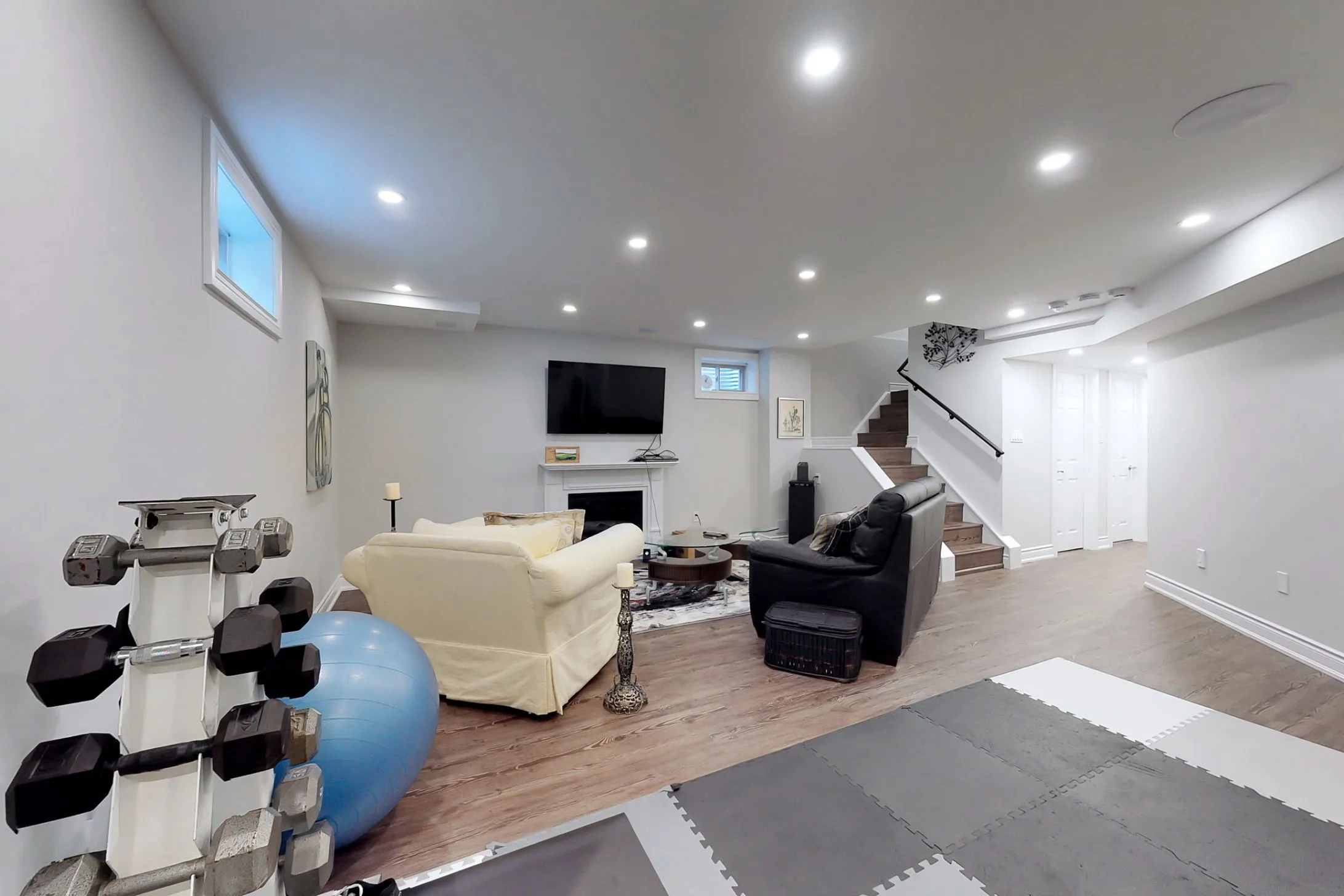
Tips on How to Budget Your Home Basement Gym
- Start Small, then Scale Up Gradually: Get the core essentials first (for example, multipurpose equipment or the gear that gives you the most versatility). This will prevent you from buying gym equipment that you may never use, and also space out your expenses over time. For example, start with a yoga mat, pull-up bar, adjustable dumbbells, and resistance bands, then as you gain clarity on your workout routine, you can get a treadmill and other equipment.
- Consider Buying Second Hand Equipment: Buying already used equipment can save you 30 to 70 percent, depending on the item and condition. Look for second hand gym equipment on online stores, Facebook marketplace, and Craigslist. Also remember to check for damaged cables on machines, overworn padding, warped parts, missing bolts, and rust to ensure you don’t buy second hand equipment that is already damaged and not useful.
- Set a Clear Budget and Track Spending: Create a realistic spending plan for your home basement gym. Break the plan into categories (like “$300 for equipment”, “$150 for flooring”), track all the expenses on a spreadsheet or app, and set aside 10% to 15% of your budget for unplanned stuff.
- Zone Out Your Workout Space: Zoning a workout space in your basement helps in planning and budgeting, and it keeps the gym separate from laundry and storage areas. For example, clear a corner or a wall space, lay down foam tiles or rubber mats, and use painters’ tape to section off the workout space.
- Use DIY Approach Where Possible: Consider building shelves for storage, parallel bars from PVC pipe, and a wooden plyometric box, which helps save on cost compared to store-bought items.
Conclusion
CSG Renovation can help you design and build your dream basement gym in Toronto while leveraging the affordable ideas we shared in this article. From choosing affordable flooring and equipment to installing space-saving and customizable storage, we are here to turn your basement into a functional workout zone. Call us at (647) 428-0007 for ideas and services for basement renovation.

